
Delivering Measured eLearning Results
Here we look at how to plan successful eLearning that will transform results across your organisation - and it all starts with defining your training needs in the context of wider business goals.
Get the planning stage nailed, with buy-in from all your stakeholders (including your learners), and the rest can fall into place and feel like a breeze.
The problem with many eLearning projects though - as with many technology projects - is that so many people leap straight into choosing the solutions before they’ve really identified and agreed on their current and future training requirements.
So here we’ll offer a step by step guide to successful eLearning for L&D managers so that your colleagues and learners will love you.

eLearning is Now an Expectation
eLearning is now a common way for organisations to deliver training and your employees are likely to have used it in some capacity - even if it’s just during their education or a company onboarding process.
It has now evolved into a standard way of making training content available any time and anywhere, enabled by ubiquitous internet access by mobile or WiFi, and by websites or learning platforms making it accessible on phones and tablets, as well as a desktop computer.
During and post-pandemic, eLearning will be the only way for training to happen at all for many organisations.
So as there are now fewer barriers to delivering eLearning and it has become so important, here are key steps for making it effective:
1. Needs Analysis and Consultation
Arguably, this is the most important part of an eLearning project, because if done well, it gets everyone on board to help you and gives you the reasoning and structure for every subsequent stage.
- Why this project? What are you looking to achieve? If you have eLearning in place already, what improvements are you looking for, and if you don’t - what do you want this project to bring?
- Is eLearning suitable? Usually, the answer is yes - as knowledge-based content allows learners to consume it at the time, place and pace that suits them. However, for some manual / skills-based roles, it may not be the case, so could traditional, face to face training or a mix - blended learning - be the best choice?
- Cost-benefit analysis - what might this project cost and what are the expected business benefits in terms of cost-saving, efficiency or revenue generation?
- What do your learners want and need? Listen to their views on knowledge and skills gaps, and where there is an agreement, look at a bottom-up approach to complement top-down from L&D and HR management. If learners feel that they have contributed to the process, they are much more likely to engage when the eLearning is ready.
2. Resourcing the Project
However small your L&D team, delivering an elearning project should always be a collaborative project and involve multiple professionals.
The same person may perform more than one, but rarely all of the roles below, so the L&D manager will need to resource at least the following:
Project Manager
Who will lay out the milestones and timescales and work to keep everything and everyone on track?
Subject Matter Expert (SME)
Depending on the nature of the training, the person or people who understand the subject and can lay out the curriculum and materials.
Instructional Designer
The person who can translate the content into the storyboards and course progression to help people learn in the most effective manner, with an understanding of what works in an electronic format.
eLearning Developer
The technician with the skills to turn the plan into the reality of an eLearning course, including text and images, audio, videos or any other media, along with the ability to track, measure and collate data on learner progress.
Unless you work within a very large L&D team, you’ll need to look outside your organisation and outsource some or all of the above roles. A specialist eLearning company will tend to have skilled professionals with experience in working well with clients or taking responsibility for the entire project efficiently.
So how do you choose the best eLearning company for your needs if you go down that route? Many will have slick sales professionals and showcase multiple awards, but what matters most is experience working with companies like yours.
If you are part of a large, global organisation, does the eLearning provider have experience at that scale and of multinational, even multilingual projects?
Do they have experience in your sector?
These details are much more important than a sales presentation!
3. Design & Development
Again, planning this stage in advance is key. Does your project need to run within a specific timescale or a particularly tight budget? Both these factors will affect the nature of the eLearning that is feasible.
What mode of delivery is most suitable for the nature of your training and your group of learners? Text and images might work well for purely informational content and knowledge retention, whereas training the ability to adapt to on-the-job situations like customer service may lend itself to scenario-based training and something more interactive.
Close collaboration between the subject matter expert and the instructional designer will allow for the content to be delivered in the best possible way while adhering to any technical constraints.
The instructional designer then needs to work closely with the eLearning developer to bring the content to life, ensuring that it works well on any device that may be used and that it is accessible for any type of current or future learner.
4. Quality Assurance
An important point here is that quality assurance (QA) is not a task to be done only by the developer as a final step. Good QA is done independently by someone external to the design and build process, as those people may have become too close to see all the potential real-life issues.
Ideally, the project managers, SMEs, and end-user managers and even selected learners will all have the opportunity to offer feedback on eLearning before it is signed off and rolled out.
5. Roll Out & Implementation
Most technology-related projects that fail do so not because of an issue with the product, but with the communication and implementation process.
New systems often turn up as yet another piece of work - something else to think about and squeeze in around the existing workload.
If there was adequate consultation at all levels during stage 1, the implementation of eLearning should arrive not as a surprise and even as a welcome addition, because the benefits to learners and managers will have been communicated and expected.
Rather than having to convince employees to engage with your new eLearning, the focus can be on guiding learners and managers in how to make it work well for them.
6. Measurement & Evaluation
How will you measure the benefits of your eLearning project?
What metrics will the L&D team measure to judge effectiveness?
What metrics do other stakeholders care about?
Along with your own learning outcomes, taking the targets of other departments into account will help to make this a more collaborative and successful eLearning project.
Don’t neglect subjective feedback alongside the quantitative results in terms of learning outcomes and business impact. How much your learners enjoy and engage with the training is an important factor when looking at how well it will work for future learning needs, and what you might want to change or tweak.
All eLearning projects are unique, but by following each of the six key steps above, you can help to minimise the common risks and maximise the benefits and overall success.

How much does an LMS cost?
How much does a Learning Management System cost? And which will appear after the implementation? We share some insights and explain, what these questions have in common with buying a house.

"The users decide whether or not a learning offer is successful'
"The goal of a learning platform must be to help people do the tasks in their job better," says Uwe Hofschröer from Learning Strategy Consulting at imc. In the Job Slot, he explains what he means by that.
Contact person

Increase Customers Live Time Value and Earn Their Loyalty
Here we look at how to improve customer service, retention, satisfaction and live time value with Customer Education.
Business leaders know that, on average, it is 5X more expensive to acquire new customers than it is to retain existing ones. Furthermore, it is usually far more profitable to upsell and cross-sell to existing customers than it is to simply increase your number of customers.
Customer education can be a powerful tool in helping you to build trust, retain existing customers and ultimately, increase customer lifetime value (LTV).

What is Customer Education?
Customer Education is learning content designed to engage new or existing customers and help them to maximise the effectiveness of your products and services.
When it's done well, it can help to reduce customer service calls and in turn, reduce costs. It can help you to retain existing customers, and even turn some of them into enthusiastic advocates of your brand.
Customer education, also known as customer training, is so important that, according to a Salesforce survey in October 2020:
“80% of customers say the experience a company provides is as important as its product or services.”
Customer education tends to be most relevant for product-based companies, whether that’s physical products or software. It can be of most benefit if your product:
- has a learning curve, where it’s common for customers to make mistakes or get stuck
- requires people to change existing behaviours
- generates frequent customer support calls
- is used by people with a wide range of needs or in diverse contexts
- is updated regularly with new features (very common in software)
- lends itself to cross-selling or upselling (customer education can be a great sales tool!).
While customer education can be delivered face to face, online training enables any time, anywhere learning that is accessible at the user’s convenience. The Covid-19 pandemic greatly accelerated the trend towards online, helping many companies to deliver up to date content even when face to face was not possible.
Online customer education provides greater opportunity to deliver training across multiple formats, including any of:
Video guides
Hosted on platforms like YouTube or Vimeo, or on your own learning management system (LMS).
Live or recorded webinars
Guide new, existing or potential customers through your product usage. When live, you can respond to any questions on the fly, and for those who want to watch it later, the recorded version can act as a useful, video-based FAQ resource.
Infographics
An engaging, fun way to present facts and figures in a creative manner.
Slideshows
A common way to quickly convert traditional, face to face presentations into an always-accessible digital format.
Games and quizzes
An excellent way for customers to test new knowledge and see if they need to return to materials or seek additional support.
Customer Education Benefits
This can greatly reduce the cost associated with large support teams and the frustration customers feel when waiting in queues.
Customers get up and running with your product quickly because they have learning materials to hand if, as and when they need it most.
A huge issue in the field of IT and software products, which inevitably come with some learning curve. Most IT implementation projects fail, not because of a weakness in the product itself, but due to inadequate customer training and in turn, user adoption.
The point at which customers are engaging with your product is often the best opportunity to highlight your related products and services. If you can win their trust in and enthusiasm for Product A and make the customer confident that they can use it, that’s a great time to draw their attention to Product B, C, D….
This is frequently the greatest benefit to a good customer education programme. A customer who is happy with your solutions because you helped them to maximise the value of it, is much more likely to renew or upgrade when the time comes.
So clearly, there are numerous benefits to making training available to your customers, but how to make this easy and cost-effective? That’s where a customer education platform can make things efficient and highly scalable.
Customer Education Platform Features
The best customer education platforms will help you to not only upload training materials to make them accessible online, but will offer a range of useful features and attributes that include:
- Integrations with popular software products like eCommerce payment gateways (such as PayPal) or CRMs (such as Salesforce) to reduce admin, while ensuring data security.
- Scalability: You’ll want your platform to handle a growing customer base, and not become a limiting factor.
- Multilingual capabilities - if you run an international company, you’ll want to make eLearning content available to customers in multiple languages
- User analytics: Data and reports will help you to learn what content and formats are engaging your customers and where people seem to struggle or switch off. This can help you identify weaknesses in your learning materials - or even the product itself. It can also help you to intelligently signpost customers to areas of your platform for additional support.
Well-designed training materials that are kept up to date and made available via a good customer education platform should be seen as an investment in customer success, retention and new business development, rather than just a cost.
Guiding users in making the most of your products should deliver increases in customer lifetime value / LTV, win you new fans, and strengthen the reputation of your brand.
Happy to help
For 25 years, imc Learning has created eLearning solutions for customer education and staff training at companies and public sector organisations across the globe.
Our clients include the likes of Deloitte, Vodafone, BASF and Audi.
If you’d like an informal chat about how we could help you leverage customer education to improve customer service and retention, get in touch with us here at imc Learning.

LMS for Membership Organisations
Make an effective LMS platform for your membership organisation with key features such as eCommerce, adaptive learning and analytics.

Learning Ecosystem: A Universe of Learning
Create a learning ecosystem in the LMS that promoted self-directed learning in the long term.
Contact person

How to Increase Channel Sales Revenue with Extended Enterprise Learning
Here we look at how to increase channel sales revenue with extended enterprise learning, whether that’s via franchisees, resellers / affiliates, distributors or even your existing customers.
If your company has a sales team, it’s common to focus your efforts as a manager on equipping your employees with the strategy, knowledge/skills and assets they need to maximise new business. However, few companies operate in isolation and there is often an extensive network of partners that could work better to help you sell more of your products or services.
That network potential is known as the Extended Enterprise....

What is Extended Enterprise?
Extended Enterprise is a term coined by Chrysler in the 1990s to describe the collaboration between a company and its supply chain to gain competitive advantage. Since then, it has broadened to encompass a company’s entire network of collaborative relationships from suppliers to logistics, retail partners and end-users or customers.
Paying attention to the entire extended enterprise (sometimes referred to as the ‘Value Chain’) allows managers to see opportunities to improve efficiency, elevate sales and maximise profits.
The concept can be applied to any 3rd parties who can directly influence the success of a business. So, by fostering more collaboration at all levels outside your own company, potential partners can be leveraged beyond them just performing their main role (i.e. doing the bare minimum).
Ways to Increase Channel Sales Performance
Here are 5 ways to increase channel sales performance that can be adopted by any marketing or business development manager with a network of partners:
1. Measure performance frequently, and from the outset
Before diving straight into a new programme of activities to boost revenue, it’s important to measure existing performance so that you can see what partners and tactics are seeing progress over time.
Establish your current baseline, then track changes consistently so that you can see patterns across activity and new business generated.
Sharing performance data with your channel partners will build trust as it will show you are invested in their performance, and will help both you and them to see what is working.
2. Incentivise channel partners
Your internal sales team is likely compensated based on business development performance. However, suppliers and logistics providers may be doing business with potential new customers. Give them a strong reason to think of recommending you - don’t limit revenue incentives to traditional sales channels, such as retailers.
3. Provide assets that communicate your brand and sales messages
Sales teams are always provided with marketing materials that communicate the latest messaging to reinforce your unique selling points and branding. However, external partners are not always given the same benefits.
By viewing every member of the extended enterprise as part of your team and as a potential salesperson, you’ll naturally think to give them all the latest materials and insights.
In the world of web hosting for example, affiliate schemes are extremely common. Website hosts often provide affiliates with a login area containing a knowledge hub of sales advice and a wide range of adverts for use on an affiliate’s own website.
4. Create bite-size learning content
If it’s your own sales team, it’s their job to study and absorb your new, 50-page product brochure. If it’s your logistics provider - they’ve got their day job to focus on and an in-depth manual will be too daunting.
Be selective and give them some bite-size learning materials that will allow them to further their knowledge of your products and services to the level where they can be a good advocate for your company.
5. Communicate proactively
Don’t just hand over new learning materials and expect the new business to start rolling in. Check-in regularly with all aspects of your extended enterprise and make sales performance a key part of the discussion. Not only will it show partners that you are serious about their sales potential, but you’ll learn about what aspects of your extended enterprise learning content is working for them. Maybe affiliates love it, but suppliers find it cumbersome. Listen, learn, tweak and repeat.
So, if you think following the 5 principles above might work for your company and your existing or potential channel sales partners, how do you make communicating and sharing knowledge and assets with them easy? That’s where an extended enterprise learning platform comes in.
Extended Enterprise Learning Platforms
The extended enterprise learning platform creates an environment for sharing knowledge and best practice, and making the latest materials available for your channel sales network wherever and whenever they need it.
Also known as an Extended Enterprise LMS (learning management system), this platform should make it easy to add or update partner training materials with little to no duplication of effort across different internal or external user groups.
Here are some of the key features of the best extended enterprise learning platforms:
Whoever creates and distributes your knowledge and sales materials for your internal and external audiences should be able to do so via a single user area.
A multi-tenancy LMS enables you to create different user experiences for different types of external partner, such as suppliers, franchisees or distributors without being distracted by irrelevant training pathways or materials. You can even create a unique ‘tenant’ area that is set up with your partner’s branding (or co-branding with theirs and yours) to make them feel at home.
Rather than handing over some learning materials and leaving partners to get on with it, you can really increase channel sales revenue by offering ongoing support and, if appropriate, allowing a level of interaction across user types. This can lead to knowledge-sharing that breeds new ideas, collaboration and synergies.
You don’t want an extended enterprise learning platform to be yet another piece of software to get to grips with and that adds another layer of logins and admin duplication. A good extended enterprise learning platform will integrate seamlessly with your existing IT systems.
While ensuring data security, system integration will allow user data sharing with HR system for internal staff and your CRM for channel sales partners for example. Single sign-on (SSO) eliminates the hassle of logging in and out of various systems with various passwords.
If you’re rolling out an extended enterprise learning platform to help boost channel sales revenue, you’ll want data on how it’s affecting performance across each part of your partner network. A good platform will give you reporting and analytics tools that give you actionable insights across geographies and partner types.
Find which content is not getting looked at to understand what is not engaging partners. See which partners are driving the most new business and align that with their use of learning and sales materials to then use them as the benchmark for best practice.
This information will help you to turn extended enterprise learning into a machine for driving new business via channel sales - whether that’s from existing partners and distributors or leveraging the potential of your supply chain.
Whoever creates and distributes your knowledge and sales materials for your internal and external audiences should be able to do so via a single user area.
Can we help you to increase channel sales revenue with an extended enterprise learning platform?
Get in touch with us here at imc Learning for an informal discussion about your needs and performance goals.

Turning a learning curve into an earning curve
Set online training up for success in such an extended enterprise learning scenario, and how to turn a learning curve into an earning curve.

Learning Management System for Membership Organisations
Make your platform effective for current and future training needs for your membership organisation.

We take a look at the difference between an LMS and an LXP, and at why the ‘Learning Suite’ is the present and future of learner engagement and training effectiveness.
For many years now, the LMS (Learning Management System) has been seen as synonymous with the idea of a Learning Platform.
While a learning platform is basically any system on which to build education and training, the LMS has traditionally been used to deliver top-down training, often focused on essential onboarding and compliance content.
As many organisations have come to realise the competitive advantage that comes with making professional and career development a benefit when it comes to employee recruitment and retention, the idea of a ‘learning culture’ has emerged.
In comes the LXP (Learning Experience Platform), which puts the individual learner in control of their training and development, allowing them to explore content at their own pace and direction.

What is the Difference Between an LMS and LXP?
So in a nutshell, the LMS delivers training in a top-down or ‘push’ manner, while the LXP is bottom-up or ‘pull’ learning. The LMS is used to deliver essential training so that the employee is capable of fulfilling their role and in adherence to any legal or regulatory compliance matters. The LXP in contrast is about giving learners the tools and content that will allow them to develop knowledge and expertise based on self-motivation.

What is an LMS?
LMS stands for Learning Management System and it is a learning platform that is characterised by formulaic progression through learning materials, with milestones and assessments along the way. A good LMS will flag essential content and refresher training requirements to learners and L&D teams, and will help both parties to identify skill gaps.
While there is greater emphasis on essential training when it comes to LMS, the learning doesn’t have to be boring though, and many LMS can incorporate multimedia content such as video, audio and animations, and engagement tools such as ‘gamification’ of content with badges and rewards or full, ‘game-based learning’.
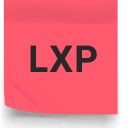
What is an LXP?
LXP stands for Learning Experience Platform (or Learner Experience Platform/Portal) and is a learning platform characterised by exploration of content, where the learner can go down various rabbit holes of learning. The training may be curated from many online sources, and by employees as well as the L&D team.
Therefore, the content library may grow and become more interesting and useful over time, rather than simply getting refreshed as company processes and the expectations of the employee change. The LXP experience is often likened to Netflix, where the learner can create their own list of content to consume, and where AI may be leveraged for a ‘recommendation engine’ that signposts suggested further content based on what the learner has explored previously.
What If You Want Both? The Learning Suite…
Clearly, the traditional LMS and LXP are very different solutions with very different goals. However, many large organisations need to manage training proactively but also want their employees to grow for their own personal development (and in turn to benefit the whole organisation).
Having a separate LMS and LXP may do the job, but creates a great deal of extra administration for HR / L&D teams, and a fragmented approach does not lend itself to learners progressing from must-have training to a culture of learning. That is one of the reasons that the HR industry analysts from Fosway Group announced that "the LMS and LXP are dead". This bold claim was one of the topics during the panel discussion between Fosway Group's industry analyst Fiona Leteney, Learning Light consultant David Patterson, and imc CEO Sven Becker. Read more about their opinions here.
In comes the Learning Suite.
With a seamlessly integrated LMS and LXP, the learning suite gives you the best of both worlds, and with no downside.
The many benefits of a modern, integrated learning suite include:
- Management of mandatory training, yet with social learning capabilities that foster peer to peer support where appropriate.
- Collaborative learning and user-generated learning. When people come together to learn and discuss best approaches, new ideas can happen. This can be captured and made available to subsequent learners, facilitating knowledge retention.
- Gamification and game-based learning - introduce game-style rewards to motivate learners or turn an entire course into a game.
- Multitenancy and extended enterprise learning for external sales and distribution partners, your full supply chain, and even your customers.
- Extensive 3rd party software integrations - your learning system could integrate with popular communication tools like Microsoft Teams and GoToMeeting, ecommerce payment gateways like PayPal and Stripe, and leading CRM systems like Salesforce.
- Content curation - develop and roll out your own training content within LMS functionality, but also curate content from external sources like YouTube or LinkedIn Learning as part of the LXP capability.
- Cost and time-savings. An integrated system should prove much better value in the first place. More importantly though, a single system for staff to get to grips with (our own imc Learning Suite is quick and easy to use out of the gate), reduces the time and associated costs of implementation and any learning curve. Ongoing administration is cut in half for HR and L&D teams.
Looking to create a learning culture within your organisation? Read more about our imc Learning Suite or contact us for an informal chat about your employee training and development needs. Our team of learning technology experts is happy to help!

The Dawn of Integrated Platforms
Setting up an entire learning ecosystem through the structure, connection via API & Artificial Intelligence are some considerations when integrating an LMS & LXP.

Headless LMS - definitely not brainless
A headless LMS makes data maintenance significantly easier while also facilitating greater flexibility and customisation, especially within a learning ecosystem comprising several systems in communication with each other.

How much does an LMS cost?
Why good planning saves time and money when investing in a learning management system
Who actually needs a learning management system (LMS)? What should you consider in your planning? Above all: How much does an LMS cost?
It is questions like these that many decision-makers are looking at when seeking to professionalise and digitise learning in their company. That is reason enough to get to the bottom of it all.
If you ask a real estate agent how much a house costs in general, they will likely roll their eyes at you and bombard you with a number of questions: What location are you looking at? How many rooms? What size? With or without a garden? Are you looking to self-build and be actively involved, or would you prefer a turnkey house? Solid construction or prefab? How do you want it finished and furnished? Laminate or wooden flooring?
There is a never-ending stream of questions needing clarification. As you can see, quoting costs without considering the parameters is not reasonable or tenable.

Bernd Heischmann, LMS expert at imc Learning
The same applies to learning management systems. As LMS expert at imc learning, Bernd Heischmann helps customers find answers to such questions, and ensures that the chosen LMS maps all requested scenarios and meets the (future) requirements. It pays to remember, that miscalculations and unnecessary changes after implementations are far more expensive than an investment based on a thorough needs analysis.
But one thing at a time: We asked Bernd about the most common questions relating to LMS costs and his tips for implementation.

Hello Bernd! First tell us, what contributes to LMS costing?
You are always looking at one-off costs and recurrent costs. One-off costs include things like implementing a customised configuration or LMS adjustment. Then you need to link other systems. Similar to a house, the planning, design and set-up of an LMS also needs to be tailored to the user so that their needs are met.
Especially in the planning phase, there are often enormous differences between different projects. In many cases, an LMS with an extensive feature set can be used “as is” and configurations are limited to a custom set-up.
If necessary, modules can be added. However, many customers want their LMS to be 100% tailored to their specific requirements. In that case, it’s worth looking at customising the system. Of course, that is more expensive than implementing an LMS in line with the existing system standard.
It is also important to remember that the “interior design” of an LMS is an added cost – for things like creating attractive learning content.
A software-as-a-service (SaaS) solution also involves recurrent fees. Typically, usage fees for such an all-in-one package of system provision and cloud hosting are charged per user. Yet, even with an alternative on-premises solution where the LMS is hosted in-house, software maintenance and support represent ongoing expenditures and hosting costs are incurred in addition to the one-off licence fees.
How big does a company need to be for an LMS to pay off?
An LMS can be a worthwhile investment for companies of any size – from SMEs to large corporations. It just depends on how it is used for what purpose. For instance, many of our customers not only train their own employees, but also their customers and partners. This helps them retain existing customers and partners, increase loyalty and attract new customers.
Many create a business model whereby they offer targeted e-learning courses in their system to third parties for a fee. The LMS then pays for itself very quickly.
We should also remember that professional development has become a major focus for employees and applicants. A company can no longer get away with neglecting training for their employees. Regular up-to-date professional development is no longer considered an optional benefit, but an integral part of a modern corporate culture that should be expected.

How long does it take to roll out a learning management system?
The technical implementation of an LMS without custom programming or sophisticated interfaces takes roughly three months. Of course, this can vary depending on the scope of the project.
Then, you also need to factor in the time to select a suitable and viable LMS and develop an effective concept for introducing e-learning in the company. Costs can quickly explode if suitability issues are only detected after implementation, or the selected system fails to evolve with the company and becomes obsolete after only a few years.
What are your top tips for a successful rollout?
As stated earlier, careful planning is absolutely crucial. Anything you miss in the beginning could turn into a major expense later on. I would therefore advise thinking carefully about future plans and other potential ways to leverage the system. If add-ons and extensions are considered from the start, a modular system that is easy to upgrade might be the answer.
Modern LMS have many functions, but different companies need different feature sets. With a modular system, the functional scope needed at a given time can be selected, limiting costs. As requirements change, additional features can be added one by one.
Stakeholder management is another important aspect. An LMS rarely involves just a single department. It usually affects the entire company. It is important to get the buy-in of key decision-makers. Typically, you are looking at IT, Personnel Development and L&D, but you might also want to consult Sales and the Works Council.
My final tip: It is vital that sufficient relevant content is available, and that you start off with excellent learning content. When the first learners start using the system, it is an absolute must the learning content they find there is exciting.
Investing in a small number of flagship projects that really inspire your learners is well worth the effort. First impressions count, and a bad impression is hard to rectify. Among our customers, the current trend for flagship projects involves learning games in 2D or 3D environments that allow learners to explore specific worlds. These look and feel nothing like traditional e-learning courses and create a unique atmosphere. You can also choose to create your own learning content, leverage content libraries or purchase off-the-shelf learning content. Simply remember that making a good first impression is key to wide-spread acceptance of the system.
Thank you very much!

How not to break bad with validated processes in an LMS
What requirements must an LMS map for validated processes? And how does Breaking Bad fit here? Questions about questions not only the Pharmaceutical industry should think about.

Learning Analytics: It comes down to the right questions
Learning must not be an end in itself, but fit in the company’s business outcome: More and more managers are demanding this. We therefore looked at how L&D managers can meet this requirement with the help of Learning Analytics.

More about our LMS
If you would like to learn more about imc's Learning Management System, check here for more information.
Contact person
I have been working in the Marketing & Communication Team at imc since March 2019.
Communication, creative content and social media are my passion. "KISS - Keep it short and simple" is my credo.
To explain complex content in an understandable way and thus make the topic of e-Learning accessible to everyone is an exciting challenge every day.
Privately I love to read, play poker and travel a lot.
I am always happy to receive feedback or suggestions.

Headless LMS – definitely not brainless
The purpose and benefits of a headless LMS
Anyone involved in software development will likely be familiar with the term “headless system” – but the same cannot be said about HR or L&D staff.
Yet, it’s worth taking a look at the topic, given that headless systems – that is, systems without their own manufacturer-defined user interface – are gaining importance in many fields. This also applies to learning management systems (LMS). That is why we created an overview of the structure and benefits of headless LMS and answer the key questions here.

Definition: What does “headless LMS” mean?
A headless LMS has no pre-defined user interface or “head”. This makes it easy to integrate its content and functions into other systems’ user interfaces, resulting in a significantly enhanced user experience. The content can be played in various formats and through different channels or devices. This means that the frontend and the backend are no longer monolithically integrated.
The LMS is used exclusively in the backend and serves as an administrative system. The functions and content are not shown via a human user interface, but through application programming interfaces (APIs). This facilitates customised frontend development and adjustment for different user groups.
Why choose a headless LMS?
It has several benefits. User experience is one of the major challenges for all learning platforms. After all, these systems house enormous data volumes, which must be played to thousands or even millions of users in a targeted and clear manner. Developing a generic user experience that is suitable for all these different user groups and use cases is difficult – if not impossible.
It is also extremely difficult to decide which content is shown to which user group (e.g., administrators, course administrators, learners, trainees), and how exactly that content is presented. The more an LMS can be tailored to a specific company and the more additional systems are integrated, the more complex it becomes. In such cases, a headless LMS can provide greater clarity, as tailored content can be shown to each user group.
How does this work in practice?
Say, a learner receives a badge or certificate for passing a course, and this is displayed in their learning status in the LMS. With a headless LMS, this progress could also be shown elsewhere – for example, in the employee’s profile on the company’s social intranet.
Third-party tools and other e-learning marketplaces can equally be integrated and shown in the same interface, removing the need for the learner to keep switching between different systems.
Some customers also use this type of system when they only want to integrate selected courses or content from the LMS into a dedicated portal they are setting up.
Headless LMS and learning ecosystem: Is it a match?
Indeed, they could make a perfect couple – but only if they can talk to each other! In this case, that primarily relates to the interfaces (APIs). A learning ecosystem comprises several systems that must maintain continuous communication with each other. If the LMS has no own frontend, it delivers its data to a higher-level system within the ecosystem which displays the information.
What benefits does a headless LMS offer?
Especially within a learning ecosystem comprising several systems in communication with each other, a headless LMS makes data maintenance significantly easier while also facilitating greater flexibility and customisation. Administrators can use a single source, rather than updating, managing and publishing the same data set on several platforms.
This data source serves the entire learning or software ecosystem and offers complete version control. The data is automatically synchronised across all interfaces that use this feature via APIs.
Flexibility increases at the same time, because administrators can precisely select the LMS components they want to display or hide. Ideally, this provides the user with a leaner user interface that is easier to navigate.
What are the pitfalls?
The things that look easiest tend to require the most work. This also applies to any software: A user-friendly, learner-centric environment requires significant technical and strategic know-how. It is important to invest in sound conceptual design to prevent incorrect content entries, buggy interfaces or frequent system fixes that may not even deliver improvements.
Once the decision has been made to purchase a learning platform, the real work begins. After a long-lasting struggle to reach a decision, the ones in charge are then highly motivated and want to start as quickly as possible with the selection of a provider and implementation.
However, they too often forget to involve important stakeholders in their own company in good time. If there is no early exchange about responsibilities, requirements or possible risks, and if other departments and employees are left out, problems are inevitable. Therefore, despite all the euphoria, first write a list and get those responsible around the table. Then go for it!

Learning Ecosytem: A universe of Learning
If you want to use a learning ecosystem successfully in corporate learning, the technical requirements must be right. Time to shed light on what systems have to fulfil in order to be able to meaningfully map a genuine learning ecosystem.

The Ultimate eLearning Jargon Glossary
LMS, LXP, SCORM, WBT, EPSS, NGLE, CBT, ITS!? Lost in a world of elearning terms and abbreviations? No worries, we can help. In this A to Z, we shed some light on the subject and have compiled a list of the most important terms and abbreviations in the field of e-learning in 2022.
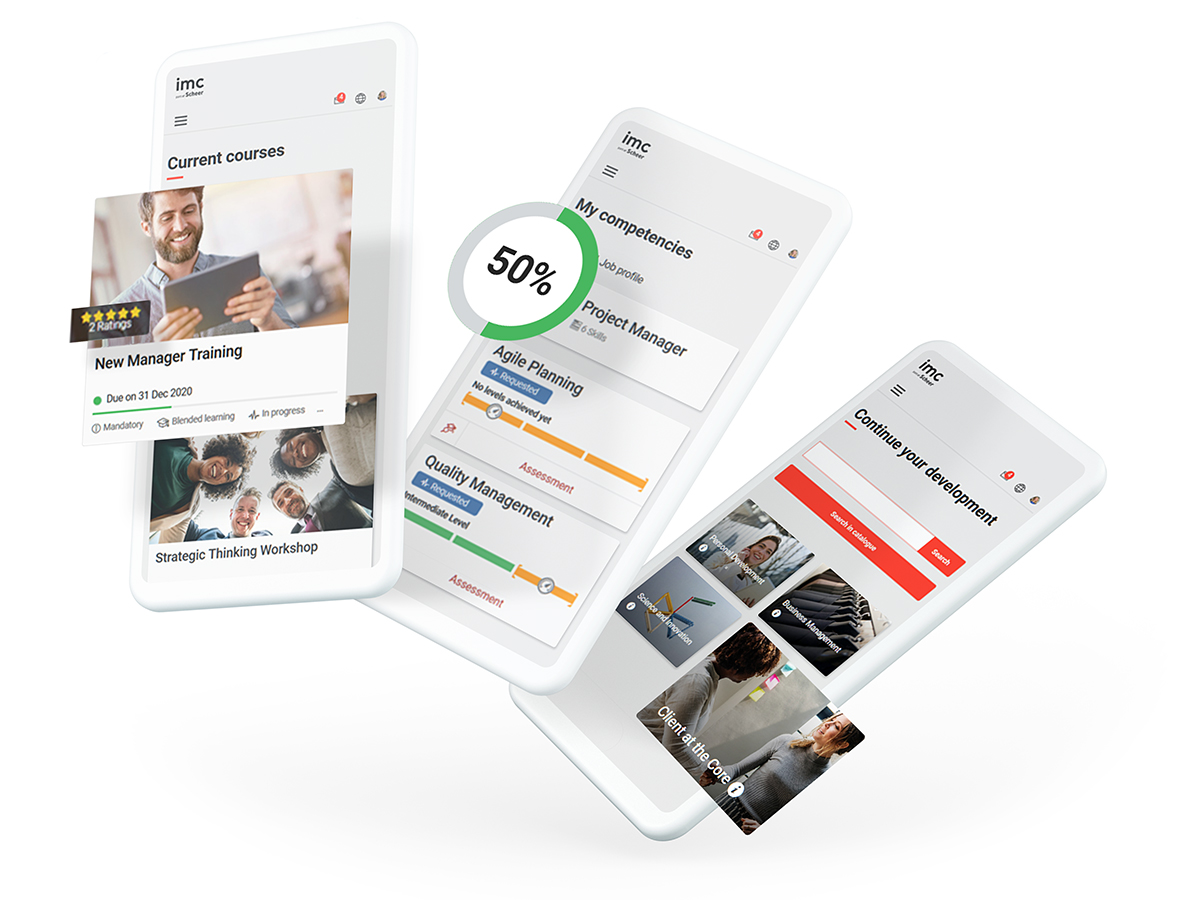
More about our LMS
If you would like to learn more about imc's Learning Management, check here for more information.

Contact person
I have been working in the Marketing & Communication Team at imc since March 2019.
Communication, creative content and social media are my passion. "KISS - Keep it short and simple" is my credo.
To explain complex content in an understandable way and thus make the topic of e-Learning accessible to everyone is an exciting challenge every day.
Privately I love to read, play poker and travel a lot.
I am always happy to receive feedback or suggestions.
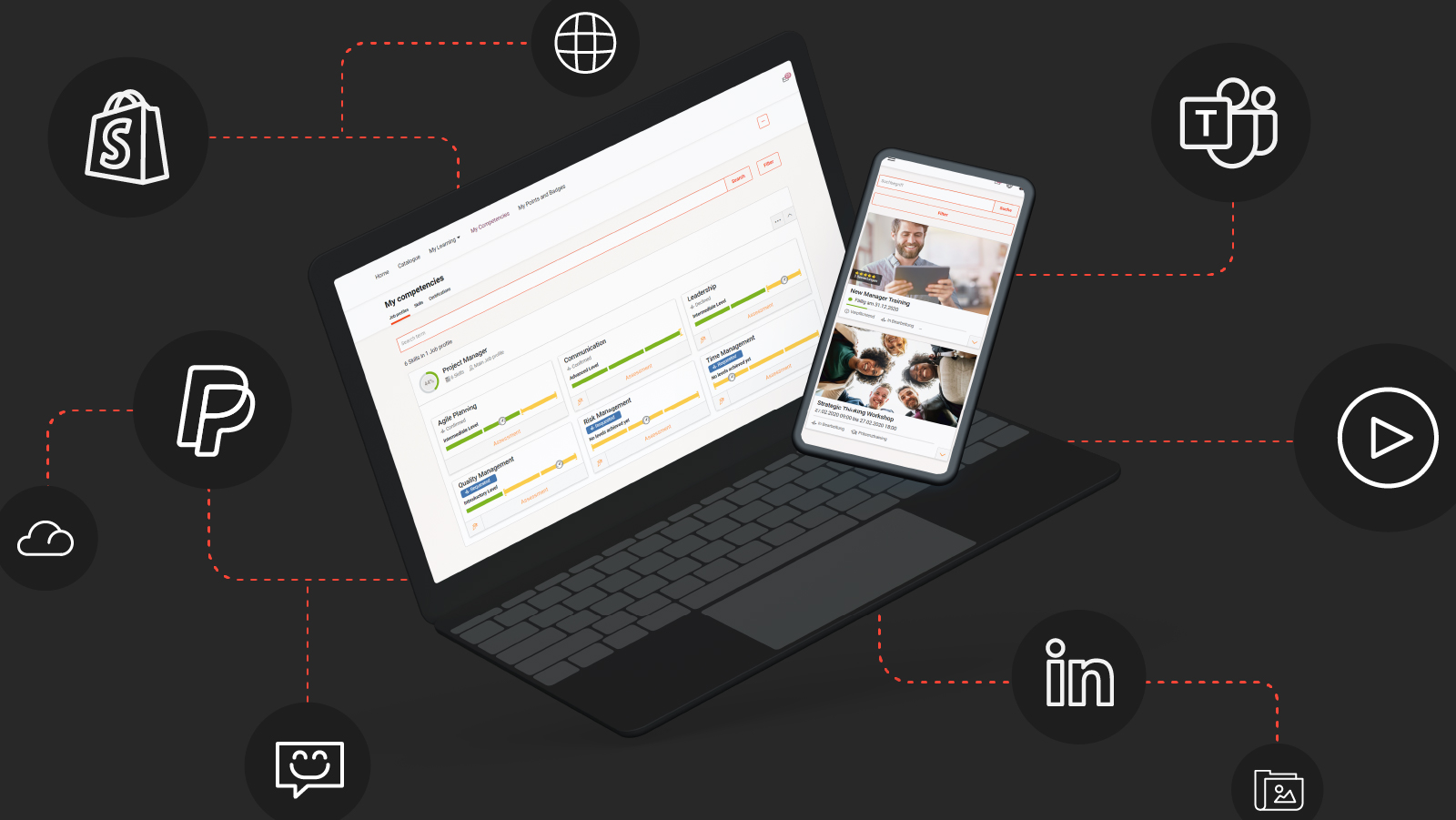
LMS Integration: Definition, Benefits, Examples & Security
It is crucial to understand the possibilities of integrating your LMS to the rest of your business software systems to measure the result of the learning & development programs. In this article, we’ll cover the benefits to L&D and the wider organisation, common examples of LMS integrations, and how to make them happen securely and with minimum fuss.
What is LMS Integration?
LMS Integration is the ability of your learning management system to receive and share data with existing software across your tech stack. It allows for the automation of many repetitive tasks and enables you to combine useful data from other software with that of your training and vice-versa.
Benefits of LMS Integration
Your learning management system (LMS) can greatly increase the reach, speed and effectiveness of your training program. However, how effective your new LMS is in driving improvements in business performance depends greatly on how well it fits in with your existing technologies.
The benefits of LMS integration include:
Little to no admin duplication across systems
With a secure connector in place, integration with that existing software means that your new LMS can be fully populated with all your learner details in minutes - not hours, days or weeks.
Faster time to competency with a new learning platform
When your LMS is integrated with your other systems and shared data is available and easy to find, your users can spend more time exploring features relevant to their needs.
Greater user adoption
When your LMS is already ready to go with information on learners and their performance from other systems, friction is reduced as users can see relevance and value in the platform straight away. Reducing friction makes your users see a new LMS as something that will make their lives easier, rather than adding to their workload.
Improved Compliance
When integrated with your legal and / or HR systems, the LMS can receive alerts when new legislation requires certain training for a group of learners or when refresher training and re-certification is required.
Enhanced data capture and learner analytics
L&D teams can link performance data from other software to learning pathways relevant to individuals and groups. For example, sales performance data from a CRM like Salesforce could trigger training suggestions in the LMS.
Better training evaluation
Training could be monitored to help evaluate its effectiveness, in order to show training ROI and any need for content improvement or interventions to support individuals.
LMS integration with popular business software products makes L&D easier out of the box, rather than at a distant point in the future.
Common Integration Examples
A large organisation will find LMS integration with a wide array of commercial software a huge time saver, and uncover a great deal of useful data. Here are just a few common examples of powerful integrations (find more about integrations on our LMS page):
Microsoft Teams
By integrating with collaboration software like Microsoft Teams, you can pull useful documents and other assets into your LMS to use as materials for training and knowledge sharing. You can also set up individual or group training sessions and peer to peer support via video conferencing. Data on all of this can be captured and analysed within the LMS.
YouTube or LinkedIn Learning
As well as creating eLearning content to be housed within your LMS, content curation is an increasingly popular way of accessing the latest and best learning materials from multiple sources. Courses and tutorials from the likes of LinkedIn Learning and YouTube can be pulled into and organised within the LMS, with learner interaction measured.
PayPal or Shopify
Training doesn’t need to be just a cost - with PayPal or Shopify ecommerce integration, you can sell learning materials and courses through your LMS, creating new revenue streams for your business.
Salesforce CRM
Organise training for sales and account managers, and for external partners - and even customers - based on their profile within a CRM like Salesforce.
Workday or SAP
Your Human Capital Management software will likely contain profiles of your entire workforce. By integrating your LMS with HCM like Workday and SAP SuccessFactors, your learning platform can be immediately populated with employee data, with training organised by role, location and more.
How to Integrate Securely
When integrating software systems - especially those accessed online - tight data security is an essential consideration. Hacking two systems together off the cuff is not the way to go, however smart your IT team is. Tried and tested connectors are important to ensure security and future-proofing of your solutions no matter who is managing your IT.
Authentication should happen via an established identity provider - be it SAML 2.0, Open ID or OAuth. Single Sign On (SSO) means that users will be able to access multiple systems, including your LMS with one username and password.
This allows stronger logins to be used (as employees need not make them overly simple in order to remember many), and when a password needs to be changed, it can be done so for all your systems with a single update.
So, above is an overview of LMS integrations, with a definition, the benefits and how to do them well. By making your entire software stack an integrated ecosystem, the LMS can play a central role in driving organisational efficiencies and business improvement. If you want to know more about LMS integrations and connectors, don't forget to visit the integrations and connectors page of the imc Learning Suite.
If you want to know more about our integrated LMS solution (imc Learning Suite), find more information here or feel free to get in touch with us.
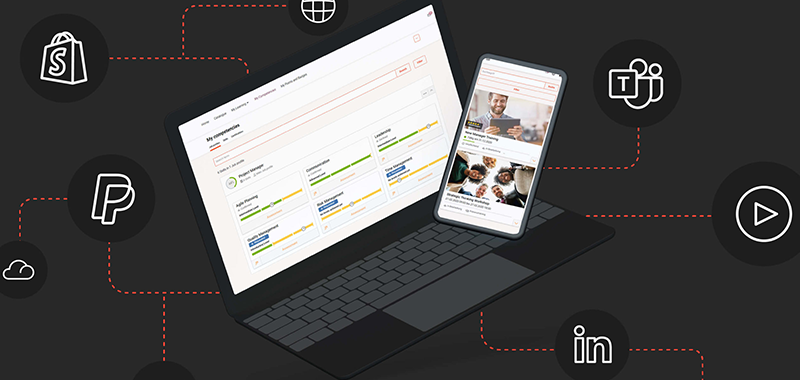
Find out imc Learning Suite Integration Features
With various add-ons and countless connectors, imc Learning Suite is one of the most customisable learning management systems on the market.

Get to know more about imc Learning Suite product updates
Our teams in product management and development are continuously working on improving imc Learning Suite to provide the best possible user experience for admins, tutors and learners.

The Ultimate eLearning Jargon Glossary 2024
LMS, LXP, SCORM, WBT, EPSS, NGLE, CBT, ITS!? Lost in a world of elearning terms and abbreviations?
Digital learning is teeming with cryptic terms, many of which are not at all self-explanatory and have various, equally-confusing alternatives.
In this A to Z, we shed some light on the subject and have compiled a list of the most important terms and abbreviations in the field of e-learning in 2024.
Jump to a relevant section or scroll on to browse…
Adaptive Learning Systems (aka Intelligent Tutoring Systems / ITS)
Adaptive learning systems gather data on the learner's activities and use this to adapt the learning journey to the individual’s observed needs. Using algorithms, the system will deliver image based content to a visual learner and interactive content to a communicative learner, or advanced content to a learner showing expertise in the subject area.
API
The term API stands for Application Programming Interface. This is a tool that acts as a bridge between two software platforms, allowing them to communicate data with one another.
In the context of e-learning, an API can be hugely valuable by allowing your learning platform to communicate learner data with related business systems, such as your HR software or collaboration tools like Microsoft Teams. This saves time by reducing the need to duplicate the management of employee data across multiple platforms.
Authoring Tool
An authoring tool is software for making it easier to create e-learning content. This could include interactive applications with which text, graphics, sound and interactivity can be combined to form a piece of content. Authoring tools can be used to create simple presentations or WBT (web-based training), or with an advanced tool - a full interactive module. No programming knowledge is required for using an authoring tool.
Learn more about our own authoring tools:
Blended Learning
Blended learning uses a combination of online and in person training to deliver training. The term often also refers to a blend of instructional methods, pedagogical approaches and technologies.
More about blended learning advice on our blog.
Cloud Hosting
Cloud hosting is the housing of digital resources or applications across multiple servers, often across multiple data centres or even countries. This can help to reduce the risk of downtime from a single machine failure.
Also known as cloud-based hosting, this can be a highly effective way for organisations - especially large, multi-site operations - to ensure speed of resource delivery regardless of location, and to scale as needed without the potential limitation of a single machine.
Conversational Learning (aka Conversational Interfaces)
Conversational learning interfaces utilise the basic concepts of social learning to create an interactive learning experience. The chatbot guides the user through the learning material with a question and answer conversation between user and bot.
Emoji's are a key part of conversational learning. Used as a replacement for body language, emoji's provide the learner with the non-verbal cues that are missing from digital training tools.
Custom content (aka bespoke content)
Custom elearning content is developed specifically for the needs of any individual client, in order to best meet their current and future training needs.
The alternative is ‘off the shelf content’, which is typically lower cost and used to deliver quick, compliance-based training. This can be good for ‘tick-box’ kind of training in areas such as basic health and safety awareness.
However, if you’re looking to use e-learning to engage learners and drive performance in the context of your business, then custom content will tend to be much more effective.
Learn about the custom elearning content development services we offer at imc.
Digitisation, Digitalisation and Digital Transformation
Digitisation is simply the transfer of assets from analogue to digital. In the context of learning, this is often taking paper based training materials or face to face classroom delivery, and creating online learning media, which is often housed in an LMS.
Digitalisation is the tactical use of digital tools to improve business processes. For example, this could be analysis of employee or team data within a performance management system (or even just a spreadsheet), in order to identify skills gaps or improvements to training materials. Digitalisation could go as far as changing a business model - for example, a physical goods store moving to ecommerce or a training company switching to selling courses online.
Digital Transformation is the broadest move that happens as a strategic shift orchestrated by the highest level of management. It is a long-term, highly coordinated series of digitalisation projects that may need to overlap and interact with each other.
Digital Transformation can be a powerful modernisation of an organisation that enables it to find new efficiencies, adopt the latest and future technologies, and literally change the organisational culture.
e-Learning
This is what imc Learning is all about - the term e-learning stands for ‘electronic learning’. Also known as elearning without the hyphen and digital learning, the word dates back to the days of installing training software to your desktop computer from a CD-ROM.
Now though, e-learning tends to be seen as synonymous with online learning and mobile learning that’s available anywhere and any time.
Electronic Performance Support System (EPSS)
An EPSS supports just-in-time (JIT) learning. In contrast to formal learning, this takes place at the point of need. EPSS is typically deployed to support a piece of software and can either guide a user through a process or act as a JIT tool, on hand to provide support when needed. The user gains independence and confidence by efficiently learning new systems and processes without the aid of expert trainers.
Extended Enterprise
An extended enterprise means a company that needs to train, for example, franchisees, external service providers, brokers, their supply chain etc. Such training can be tackled strategically and efficiently by creating learning portals, customised for each type of audience, built into your LMS.
Game-Based Learning
The term Game-Based Learning refers to learning experiences that are delivered through the use of a game. A learning environment must be created that is attractive for the user, in which he or she can develop through positive, entertaining learning experiences.
More Game-Based Learning advice on our blog.
Gamification
This term refers to player motivation principles, such as rewards, to drive learner engagement. Gamification elements within training could be scores that are displayed to the learners and allow them to compare themselves with other players. Further gamification elements are badges and badges, which are awarded after completed tasks.
Gamification principles for motivation can be incorporated into training without the learning experience actually involving a game.
Instructional Design
This is a skill and process that combines foundational principles in learning psychology with the latest available technologies to design content for the best possible learning experience. Trends in recent years have moved towards learner engagement, as well as the effectiveness of content, helping people want to follow the training materials.
Multimedia content options, such as video that is now more accessible with ubiquitous, fast internet access, and principles such as gamification and games-based learning, are now key elements of the instructional design toolkit.
Modern e-learning software, such as our own authoring tools, allow L&D professionals and subject matter experts with no formal industrial design training to create effective learning content.
Interactive Learning
Interactive learning requires a greater level of learner involvement than the stereotypical, ‘click next’ e-learning experience. Interactive training content has been shown to bring better learning outcomes than a passive learner experience, as it tends to be more engaging and forces the learner to process information and put their learning into action.
Interactive Video
Interactive videos are films that allow learners to decide for themselves what they want to see next. The learner is thus not only a passive viewer, but actively determines what he or she sees and learns.
Learning Experience Platform (LXP)
The LXP is a relatively new concept that takes e-learning beyond a top-down, employer-led platform into being a more immersive environment where employees can explore what to learn next. This allows them to proactively develop their own knowledge and skills.
Many LXPs take principles of context exploration and recommendation engines from the likes of Netflix. They can be a key tool for large companies to encourage a culture of learning.
Learning Nuggets
A learning nugget is a short learning unit or a building block or a mini module in e-learning that usually lasts no longer than five minutes. The term is often used in connection with Micro-Learning.
Learning Management System (LMS)
A Learning Management System, (LMS for short) is software used to digitally host, manage and track learning content, which is typically assigned by tutors to their learners.
More about Learning Management Systems on our Learning Suite page.
Learning Content Management System (LCMS)
A Learning Content Management System (LCMS) is software that enables the creation, storage and management of reusable learning objects. It also enables web-based learning to be organised and maintained by multiple authors. An LCMS combines the functionality of an LMS and a content management system (CMS).
Learning Record Store (LRS)
A Learning Record Store is connected to an xAPI or Tin Cab and collects, stores and retrieves data and learning activities. An LRS can be integrated into an existing LMS.
Learning System Suite
The concept of the Learning System Suite is a combination of an LMS and LXP, as well as a NGLE.
It provides all the top-down training delivery and assessment capabilities associated with a Learning Management System (LMS) for the essentials of onboarding and compliance, combined with the intuitive and engaging environment of a Learning Experience Platform (LXP) and the broader ongoing training, collaboration and interoperability you might consider to be a Next Generation Digital Learning Environment (NGDLE) (or NGLE).
The imc Learning Suite is built for exactly this purpose - a solution for learning management, experience and performance all in one place, while integrating seamlessly into your existing tech stack.
Micro-Learning
Learning content is divided into small units or building blocks for the user to access as individual elements at any time. This flexible approach is also often termed as 'learning nuggets'.
Mobile Learning (M-Learning)
Mobile Learning refers to training accessed through mobile devices. This makes the learning experience more flexible and more independent of time and location.
Mobile Learning modules are typically designed primarily for a smaller screen size, especially phones, enabling any time, anywhere learning. This requires streamlined content that is less taxing on bandwidth, and a different approach to user navigation.
More about Mobile Learning on our blog.
MOOC
A MOOC (a Massive Open Online Course) is an online course aimed at a large number of participants and is usually free of charge. Pioneers of this format are Stanford University, the Massachusetts Institute of Technology (MIT) and Harvard University.
Multi-tenancy LMS
In the field of software, the term multi-tenancy refers to a single application (so in our context, the LMS) shared by multiple user groups who each experience their own, individualised learning environment. This means that different user groups can have different learning portals (each with its own entry portal, its own features, user rights, content, look & feel, etc.), while the system is centrally managed through a single LMS.
This can greatly reduce the cost and time needed to adapt the training experience for different teams, partner organisations, or even customers.
Read more about multi-tenancy LMS solutions in our in-depth article on the topic.
Next Generation Digital Learning Environment (NGDLE)
L&D professionals and industry commentators have been bemoaning the limitations of learning management systems and predicting their imminent death almost since they were invented. One of the key complaints is their closed nature that requires a great deal of additional administration alongside other business and HR systems.
The idea of the Next Generation Digital Learning Environment or NGDLE is that it opens up a learning and people performance ecosystem of tools with open standards and principles, perhaps with single sign on (SSO), which will greatly reduce the siloing of learning assessment, collaboration, feedback and general communication.
Some people drop the ‘Digital’ as a given, giving us NGLE.
Our own imc Learning Suite is an example of such an integrated solution that plays nicely with other popular business tech solutions.
On-site Hosting (aka on-premise hosting)
In contrast to cloud hosting where data can be stored on multiple servers, and possibly even across multiple territories, on-site hosting will house data at a single client location.
While data security has generally improved over the years and many organisations have moved entirely over to the cloud, on-site hosting can still be appropriate for some organisations where security is of extra concern, and / or to ensure compliance with specific industry or local regulations.
The downside of on-site / on-premise hosting compared to cloud tends to be reduced scalability as resource needs grow or the economies of scale associated with a company maintaining thousands of machines at one or more data centres, rather than a small number on-site. However, this is not a concern for some single-site organisations.
On-the-Job-Training (OJT)
On the Job Training refers to learning that takes place alongside activities at the workplace, and usually under the guidance of a colleague, coach or mentor or also through an EPSS. In colloquial terms, "learning by doing" refers to this type of training.
Performance Management System
A performance management system enables the ongoing, regular monitoring of employees against KPIs and individual targets. These targets and expectations will be set to support collective contribution towards the wider organisational strategy.
A good performance management system will include learning resources to help support individuals and give them data on their own performance, while providing a management dashboard so that L&D and HR teams can identify an issues, in order to offer additional support or intervention where needed.
The imc Learning Suite incorporates the functionalities of a Performance Management System in the LMS. With its extensive Learning Analytics modules, the imc Learning Suite provides both learners and tutors as well as managers with clear dashboards regarding the learner's progress and performance.
Predictive Analytics
The leading modern learning management systems can aid in the use of learner data to identify potential training requirements of individuals or certain groups.
Predictive analytics is a foundation of adaptive learning systems and learning experience platforms.
REST API
API (Application Program Interface) as explained above is a general set of protocols that enables various software to interact and communicate data between each other. REST API or RESTful API (Representational State Transfer) is a subset of this that deals specifically with web applications and is mostly used to handle HTTP requests.
SCIM
The abbreviation SCIM stands for System for Cross-domain Identity Management and is one of the open standards for managing user information across platforms. In the context of L&D and HR, it can greatly streamline IT tasks and reduce admin time when using cloud-based apps and services, as it allows your IT team to automate many repetitive tasks, such as employee details and learning requirements.
SCORM
The abbreviation SCORM stands for "Sharable Content Object Reference Model" which references the digital packaging of e-learning courses. Through this format, SCORM courses can be imported and launched through any SCORM compliant platform. Industry standard LMS all include SCORM players.
Serious Game (related terms: Adventure Game or Learning Game)
Serious games are not exclusively for entertainment purposes, but instead convey knowledge or skills through playful actions. See also: Gamification and Game-based Learning which aim to engage and motivate learners through adventures and competition.
Social Learning
Social Learning promotes an interaction between learners through sharing learning experiences. e-Learning can include social elements through comment functions, social media postings, instant messages, forums, wikis, video chats, etc. which can typically be integrated with modern LMS. In addition, virtual communities can be set up to exchange ideas, knowledge and new contributions.
More about Social Learning on our blog.
Validated Learning Management System (VLMS)
Many companies – for instance, in the food, pharmaceutical or medical sector – need to meet strict regulatory requirements such as FDA Title 21 CFR Part 11. These requirements include that all processes leading up to the production of a product have to be documented and verified at any time. This also applies to employee training, as it is an essential factor in the quality management process.
A Validated Learning Management System (VLMS) - like the imc Learning Suite - enables organisations to make their training processes compliant with these strict requirements. Read more about Validation and Validated Learning Management Systems here.
Video-Based Learning
Learning through videos is popular with both employers and learners as it can convey much more information than static formats in a short space of time, and can appeal to those who prefer visual or auditory content. Videos can be designed and animated in different ways to contextualise learning, or directed by real people - 'characters' - who guide learners through a topic. 'Explainer videos' can be highly effective for onboarding new staff and introducing new concepts.
An advanced use of video-based learning is the interactive video.
More about Video-Based Learning on the blog.
Web-based Training (WBT)
Unlike computer-based training (CBT), no specific software installation is required. Instead, with WBT, the user accesses learning materials via a website or online learning platform.
xAPI (also Experience API or Tin Can)
xAPI is often seen as a further development of SCORM. In principle, learning content and learning management systems (LMS) can exchange information with each other in order to record a wide variety of data and learning activities.
To this end, xAPI has redefined some of the basic practices for tracking learning experiences. The main difference between xAPI and SCORM is the type of learning that each participant can follow.
While SCORM is limited to recording online learning, xAPI can track almost any activity. Here xAPI provides a much more detailed view of learning progress, both online and offline.
Different learning methods that xAPI can track include reading a web page, attending an event, borrowing a library book, playing a game, blended learning, and team-based learning. The xAPI data is stored in a Learning Record Store (LRS).
Do you miss anything?
We hope we’ve shed some light on the most mysterious e-learning terminology.
Do you have any questions, additions or suggestions?
Feel free to contact us!

Convincing stakeholders for an LMS
The success of introducing a learning management system hinges on those responsible for the launch taking due account of their stakeholders - and not underestimating them. We have compiled some expert tips and a checklist to help you in convincing your stakeholders.

Stop boring software trainings!
Stop boring software-trainings! That is the mission of Sarah Hillmann, Trainings Specialist and Business Consultant. She has prepared a new way to train customers for using imc's Learning Management System (LMS).

More information about the LMS
If you would like to find our more about the Learning Management System of imc, please find all information here.
Contact
I have been working in the Marketing & Communication Team at imc since March 2019.
Communication, creative content and social media are my passion. "KISS - Keep it short and simple" is my credo.
To explain complex content in an understandable way and thus make the topic of e-Learning accessible to everyone is an exciting challenge every day.
Privately I love to read, play poker and travel a lot.
I am always happy to receive feedback or suggestions.

Learning ecosystem: A universe of Learning – why you need it, how you build it
Discovering new worlds of corporate learning
The L&D sector has largely reached a consensus: Customisation must play a bigger role in corporate learning. We must strive to democratise knowledge. The panacea needed to achieve these ambitious goals? A learning ecosystem. The focus is almost exclusively on soft factors related to the corporate and learning culture when establishing such a system, neglecting technological aspects.
Yet, suitable software such as a learning management system or learning experience portal is vital. Let’s take a step back to grasp what a system needs to achieve to map a meaningful learning ecosystem.
Inflexible systems and uniform learning paths for all employees are a thing of the past. Nowadays, companies face the challenge of creating a learning ecosystem that promotes self-directed corporate learning in the long term.
Such a system links various platforms and creates a clear structure for the different formats within a learning portal. The search function leverages all integrated systems, taking account of both internal and external sources.

Andreas Pohl, Director Research & Development at imc
So much to the theory. The question now is: What technical structure enables a learning ecosystem to meet all requirements and offer real benefits to the employees?
What role does a learning management system (LMS) or learning experience portal (LXP) play within such learning universe?
imc expert Andreas Pohl, Director Research & Development, leads the development of such systems. Thanks to his many years of experience, he is very aware of the hidden potential learning ecosystems offer.

Hello Andreas! What would a learning ecosystem look like in practice? Can you give us a specific example?
Let’s say we have an industrial client who manufactures special parts for large-scale equipment. All new employees and trainees must know how to use the equipment employed to make these parts.
They train on a training machine to learn the workflow. Now, it is possible to link this training machine to a learning management system (LMS). In that case, a new employee could log into the training machine with their personal identifier. Once they have mastered the workflow, the machine automatically transmits the training success to the LMS where the training is marked as complete.
This is then booked in the employee’s learning path or as learning progress – for instance, as part of their on-the-job training. Thus, the communication between the different systems makes learning easier. This example might be a little staged, but I think it illustrated the practical application of a learning ecosystem very well.
What does a learning ecosystem need to do to make learners use them?
Before you start thinking about a learning ecosystem, a suitable cultural framework must be in place.
As an employer, I need to motivate employees to use a system and allocate time for that purpose. At the same time, the user experience of the learning ecosystem (LE) must be structured in such a way that the employees enjoy using it, and make it easy for them to find relevant content.
A user will be far more likely to use the system when they can see an immediate and direct benefit. If that benefit is not obvious, you have lost.
How do you realise that from a technical perspective?
There are two approaches: First of all, I can make the LMS or LXP the central hub for my learning ecosystem. In this case, the LMS also needs to be able to present contents from external sources.
The learner can find materials from the entirety of the ecosystem through the frontend of the LMS. It makes no difference to them where learning content is stored – in the company LMS or, for instance, an integrated content library. For the learners, it is important that the system is easy to navigate and that they can quickly find relevant contents without jumping through hoops. Whether or not this takes them into a different system is irrelevant.
The second approach is to subordinate the LMS to the overarching portal. Rather than being at the centre itself, it delivers its results to the top level. This is useful when a central portal already exists and the LMS is integrated at a later stage.
How does an LMS become part of a learning ecosystem? What are the prerequisites?
In the second case – when the LMS is a cog in the wheel – the contents must be supplied to the overarching system. Indexing then becomes a major factor. That means that content must be provided in a format that triggers useful search hits presented and shown in a meaningful manner. The same applies to recommendations the system gives the user based on learning habits or interests.
Good APIs (application programming interfaces) are the key success factor for these types of functions. They facilitate the communication between the different applications. Effective and standardised interfaces are always important in IT, but whenever several systems come together, they become absolutely crucial.

How does an increase in content affect the individual interfaces and components?
This is a very interesting question. Let’s break it up into two parts. To illustrate: Your universe might grow because the number of planets is increasing, or because the existing planets are becoming more populated. These are two very different scenarios.
Similarly, you can expand your learning ecosystem by integrating or linking new components, or by adding more content to the existing elements.
After all, the purpose of a learning ecosystem is to continuously and frequently change the volume of the learning content, and the integration of user-generated content (UGC). Going back to our analogy, user-generated content merely increases population density on a given planet. From a technical perspective, this is not a critical process, as the growth takes place within an existing system with no effect on the complexity of that system. It would therefore not qualify as a true expansion.
So, what is “true” expansion? What do we have to watch out for?
I would say a true expansion of the ecosystem involves the integration of additional systems or a new interface. This expansion process is somewhat slower, as each new system needs new interfaces or gateways.
Each “planet” needs to provide the information within the LMS to the other “planets” – and ultimately the user – through standardised interfaces, and various APIs as well as an event bus are utilised for this purpose. Meanwhile, the central system must be able to absorb content and integrate it in its search function to make it accessible to its users.

How does the system know which content should be shown?
The system can only show content it knows. That means either the index content must be transmitted to the system – for example, via a data or event bus – or the system must have direct access to the index. Naturally, this can only work if indices are properly maintained and clearly structured.
What role does the data or event bus play?
An event bus is basically a messaging system. One system throws a message onto the bus, the bus takes off, and the next system can retrieve the message.
The message does not disappear after it is retrieved by one system – it remains available for the other systems. For example, systems A, B and C “take” the message, but system D ignores it, because it’s not relevant to it. Meanwhile, system D might “take” a different message that A, B and C are not interested in. Messages are thus distributed in real time, making manual message transfer to each system redundant (publisher-subscriber approach).
The challenge with this approach is that each system involved must be able to understand the message contents. This often requires some adjustments, as some systems might not be able to translate it directly. This is a major current topic for our development team.
What trends would you say can make learning ecosystems even better?
There is certainly room for improvement in system alignment, which also encompasses IoT (internet of things) and ESB (enterprise service buses). In other words, systems need to know both, which message they need to retrieve from the bus and which immediate adjustments they need to make.
This reduces the need for system adjustment. Now, an ESB is not a trivial thing, and might be overkill for a straightforward set-up with a small number of systems. However, my learning ecosystem is fairly complex and serves more than 10,000 employees, it makes an enormous difference.
Another thing we are working on at the moment is switching over to external contents. Right now, we can integrate external content in the search through our LMS, for example, through the LinkedIn Learning Content Importer. We want to expand that capability to enable the user to switch directly into the external system. We are currently collaborating with a major client to achieve that.
Finally, what should we pay particular attention to? Where do you see the most potential? Are there also disadvantages?
It comes at a cost. None of this is free. Everything we talked about needs investment. The systems need to be maintained continuously, as do the connections to the interfaces, and some of these systems might be proprietary. It’s not an automated process.
Ideally, that will enable me to create a learning ecosystem which optimises how the different needs of all my learners are met. Everything then comes from a single source, which is a whole lot more user friendly and actually feels like one system. A good learning ecosystem goes a long way towards improving the learner experience and providing real support to employees in their daily work.
My advice: Good planning is half the battle! It is important to clarify from the outset what you want to achieve, how many systems should be maintained and how much maintenance can be provided.

How not to break bad with validated processes in an LMS
What requirements must an LMS map for validated processes? And how does Breaking Bad fit here? Questions about questions not only the Pharmaceutical industry should think about.

Learning Analytics: It comes down to the right questions
Learning must not be an end in itself, but fit in the company’s business outcome: More and more managers are demanding this. We therefore looked at how L&D managers can meet this requirement with the help of Learning Analytics.

More about our LMS
If you would like to learn more about imc's Learning Management System, check here for more information.
Contact person
I have been working in the Marketing & Communication Team at imc since March 2019.
Communication, creative content and social media are my passion. "KISS - Keep it short and simple" is my credo.
To explain complex content in an understandable way and thus make the topic of e-Learning accessible to everyone is an exciting challenge every day.
Privately I love to read, play poker and travel a lot.
I am always happy to receive feedback or suggestions.

Learning Management Systems in schools
The frequency of using a learning management system (LMS) has increased significantly compared to the time before the Corona Pandemic. There are many ways to use an LMS, but the questions arise: Which functions are really important? What should schools look for when introducing an LMS? We have summarised the most useful functions.
The use of learning management systems (LMS) was pushed forward mainly because of the Corona Pandemic and since then many schools cannot imagine teaching without them.
A survey showed the frequency of the use of learning management systems in the classroom.
Evaluation before Corona
- 9.3% used in most lessons
- 29.9% used in some lessons
- 63.7% never used
Current evaluation:
- 38.9% used in most hours
- 19.1% used in some hours
- 42.7% never used
Learning platforms enable digital exchange between teachers and learners, promote self-directed learning by students and facilitate the provision of teaching materials. But not all LMSs are the same.
Learning platforms differ in terms of their complexity and functions. You should therefore consider in advance which criteria the learning platform in your school should fulfil and for which tasks it should be used.
We have summarised the most useful functions that every learning platform in a school should fulfil, in an infographic, which you can also download free of charge at the very bottom.
If you would like to know which of these functions the imc Learning Management System for schools fulfils, please contact us.
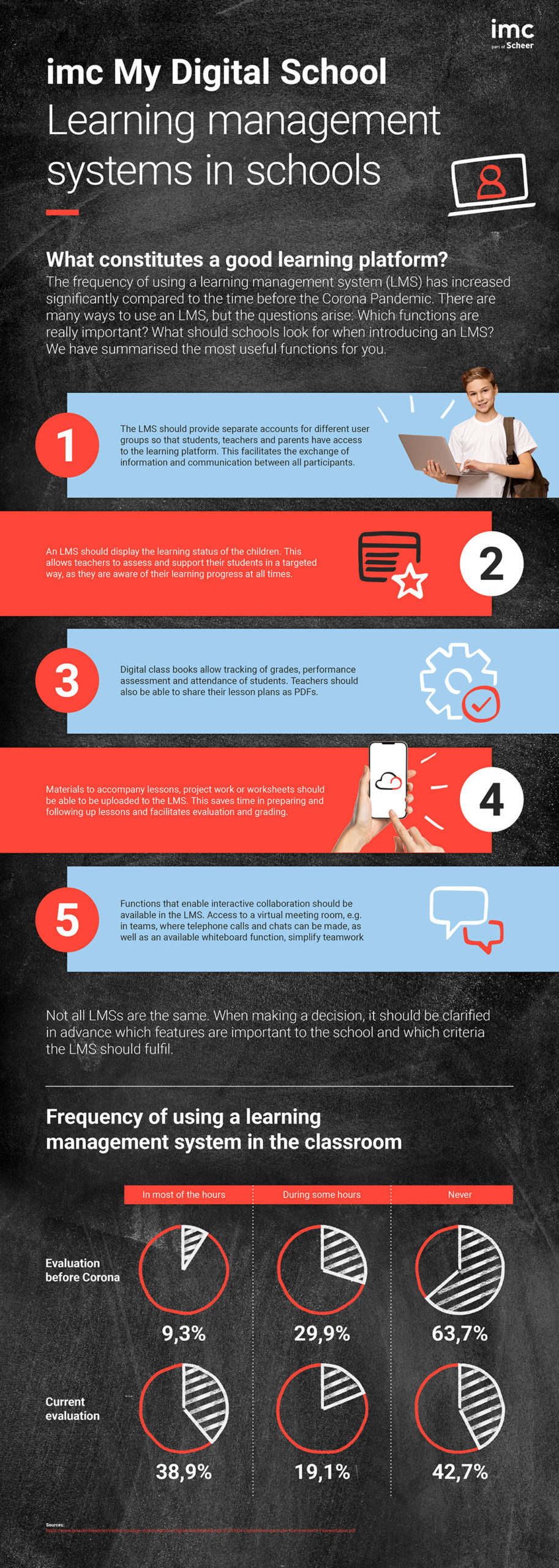
Infographik of the Month: Learning management systems in schools – What constitutes a good learning platform?
Download and further information
The info graphic you can download for free as PDF.

The Future of Learning & Education
In this episode we take a look at how digitalization effects both Child and Adult education.

Courage to the LMS!
In an interview, Christian Mai from S&G, reports on his experiences with the implementation, gives practical tips and explains why an LMS can even increase the appreciation of employees within the company.
Contact person
I have been working in the Marketing & Communication Team at imc since March 2019.
Communication, creative content and social media are my passion. "KISS - Keep it short and simple" is my credo.
To explain complex content in an understandable way and thus make the topic of e-Learning accessible to everyone is an exciting challenge every day.
Privately I love to read, play poker and travel a lot.
I am always happy to receive feedback or suggestions.
